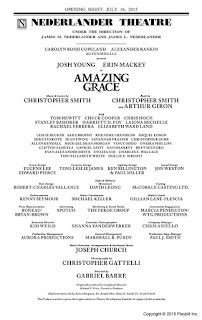"Could Be Brighter"
 |
| Stars range from 5-1. |

 One-person plays, which form a regular part of every
theatre season, come in many shapes and colors. Some are biographical or autobiographical;
others are ruminations on art, politics, history, or sociology; others revisit
actual events; and yet others are fictional, either original stories or ones based
on existing sources. The performer may play anywhere from one to many
characters.
One-person plays, which form a regular part of every
theatre season, come in many shapes and colors. Some are biographical or autobiographical;
others are ruminations on art, politics, history, or sociology; others revisit
actual events; and yet others are fictional, either original stories or ones based
on existing sources. The performer may play anywhere from one to many
characters.
THE ABSOLUTE BRIGHTNESS OF LEONARD PELKEY, directed by Tony Speciale, and written by and
starring James Lecesne, who plays multiple roles, is a work of fictional drama
adapted from the playwright’s own 2008 young adult novel, ABSOLUTE BRIGHTNESS. (Lecesne won an Academy Award for his 1994 short film, TREVOR, about a teenage suicide.) It
was first shown earlier this year at Dixon Place, where it received very
positive reviews, especially from the New
York Times. Because Mr. Lecesne is able to sharply differentiate each character,
young and old, male and female, with barely any help from props or costuming,
his performance is undeniably a tour de force of acting versatility.
 |
| James Lecesne. Photo: Matthew Murphy. |
A trim, good-looking man of 60, who looks considerably
younger, Mr. Lecesne wears dark slacks and a close-fitting navy blue shirt, its
long sleeves rolled up past his elbows (Paul Marlow is credited for the “clothing”).
Assuming the role of Chuck DeSantis, a detective in a small town on the New
Jersey shore, he has a masculine timbre, overlaid with a convincing Jersey
accent. Nothing in his voice or manner couldn’t reasonably be accepted as
belonging to a small town Jersey cop. But as he tells his story he makes split-second
transformations—sometimes for only a single line—into other people, each of
whom has distinct vocal and behavioral characteristics. All are somehow connected
to the disappearance and death of Leonard Pelkey, a flamboyantly gay 14-year-old, whose
mother’s dead, whose father appears to have abandoned him, and who’s been taken
in by Ellen Hertle, a local beauty salon owner. His case ten years
earlier, we’re told in the detective's snarky style, was notorious enough to put the town on MapQuest.
The people we meet—most get a colorful,
character-revealing monologue—are Marty Branahan, a loud cop in DeSantis’s
office; the hot-looking Ellen, who says “toym” instead of “time,” and who reports Leonard’s
absence to DeSantis; her 16-year-old daughter, Phoebe, who protected Leonard
from bullies; Buddy Howard, Leonard’s fey drama teacher, with his affectedly
upper-class British accent; Gloria Salzano, a Jersey-accented, binocular-wielding bird-watching mob wife who made an important discovery in the search for Leonard; Marion Tochterman, yet another Jersey-accented woman, a chain smoker with the rasp of a rotten esophagus, whose
invisible smoke you can practically see curling up toward the flies; the
elderly Otto Beckerman, a once-but-no-longer homophobic clockmaker who benefited from
Leonard’s friendship, and whose German accent offers a welcome respite from all
those Joisey vowels; and Travis Lembeck, a wise-ass teenage video-gamer known to have
bullied Leonard.
We discover how deeply Leonard, despite his
eccentricities--most notably his pasting the soles of half a dozen flip-flops
together to create a pair of platform sneakers--affected the lives of all who
came in contact with him by being his own person, fearlessly living as he chose
to, and offering life-affirming advice (like how the local women should dress)
to one and all.
The script sometimes aims for a Raymond Chandler vibe,
giving the detective’s narration in ersatz macho dialogue like this, when Ellen
comes to report Leonard missing: "She was what they
used to call in my line of work, 'a dame.' A steady looker with legs up to here,
an impressive rack and the kind of in-your-face-attitude that could have you
leaning up against a bar before noon knocking back shots of Johnny Walker."
A similarly clichéd quality clings to everyone, each
of whom, regardless of how well Mr. Lecesne limns them in performance, has an
unsurprising familiarity. The audience when I attended didn’t seem to mind, however,
and laughs erupted throughout, even at the most innocuous remarks, gestures, or
intonations. The language is definitely colorful and there are some funny lines, like when Ellen says of
her gay Uncle Paulie that “He didn’t identify as a BLGT or whatever,” but neither
I nor my guest viewed the show through the laugh riot spectacles everyone else seems to
have been wearing. As for the mystery behind Leonard’s disappearance, the facts
eventually emerge in as contrived a manner as on any TV procedural, although,
apart from some comments about the presence of evil, and the inclusion of a trial, we never learn the motive
behind what happened.
Nothing (apart from the sight-obstructing pillars in
the downstairs Westside Theatre) detracts from the storytelling on Jo Winiarski’s
simple set, consisting mainly of a table with various props on it. Matt Richards’s
lighting, Duncan Sheik’s original music, Christian Frederickson’s sound design,
and Aaron Rhyne’s projections all contribute effectively to the overall effect.
But, apart from Mr. Lecesne’s display of his considerable mimic gifts, THE ABSOLUTE BRIGHTNESS OF LEONARD PELKEY might be described as moderately, not absolutely, bright.
Westside
Theatre
407
West Forty-Third Street, NYC
Through
October 4

















































